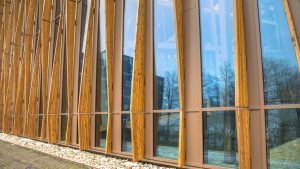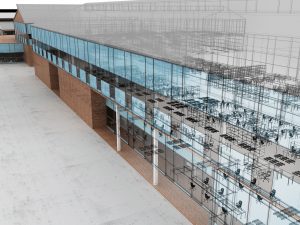The frightening side effects that our decisions on earth are having on the planet are becoming more and more prominent. It’s time for us to look at our actions and see what we can do to stop these repercussions once and for all. Here, we will discuss whether it is enough to simply reduce our environmental impact.
Too often, companies across the globe talk about being kind and ‘less bad’ when it comes to their environmental impact. Here at Buildpass, we talk about reducing our footprint and choosing the friendlier choices, but one question we want to ask is… Is this enough? Are we really going to hit Net Zero by 2050 if we carry on making small steps here and there?
Research from the Climate Change Committee shows that the UK could get to net zero as early as 2042, HOWEVER, this would only be achieved if a tough list of requirements are met from the public and businesses across the UK; for example, the public would need to eat less meat and dairy, use less aviation as well as have every new car and replacement boiler zero-carbon by 2035.
The absolutely shocking figure for us is that in the building industry, we make up 40% of the world’s carbon emissions. It also heavily contributes to landfill waste and considerable air, water and noise pollution. So, as we begin to see the horrifying effects global warming is having on the planet, we all need to stand up, pay attention and take the next step to work towards hitting the Net Zero initiative goal. There are so many areas that we need to address to become truly regenerative and we’re going to discuss them in more detail throughout the blog.
Waste generation
It’s well known that the construction industry creates a large amount of waste generation that needs to be disposed of shortly after completion of the development. We also have to take into consideration the end of a building’s life, where materials need to be deconstructed or demolished, which again generates a significant amount of waste too. Construction waste can include:
- Insulation and asbestos materials
- Concrete, bricks, tiles and ceramics
- Wood, glass and plastic
- Cement
- Metallic waste such as cables and pipe
- Paints and varnishes
As the construction industry starts to see the harsh impact it has on the environment and we become a more eco-friendly society, more options for reusing and recycling materials have been introduced, but despite this positive change, a huge amount of construction waste is still being disposed of in landfill. Around 32% of landfill waste comes from construction and demolition of buildings.
This high statistic can be very disheartening, but there’s ways for us to do our part and reduce waste generation. Plans such as a site waste management plan (such as BREEAM) can be introduced before construction begins at your site. This will describe to you how materials will be managed efficiently and disposed of legally during and after the construction process. It also explains how the re-use and recycling of materials will be maximised, giving you full knowledge and ability to make the most environmentally friendly decision.
Other types of construction waste may be able to be minimised; for example, products which are provided with reduced packaging or those that are created from recycled materials. There might also be opportunities to re-use materials and products which are in suitable conditions such as doors, windows, roofs and tiles.
Reducing carbon
As the construction industry currently takes up a staggering 40% of the carbon emissions, it is essential that we work harder to lower our carbon footprint. Carbon emissions can come from the manufacture to the transportation of construction materials so there’s a few different approaches to take when reducing construction generated CO2. Here’s a few different ways that reduce our footprints:
- Materials
When you begin to design or renovate your building, make sure to plan which type of material you will be using and how to utilise it. Using sustainable and energy efficient materials will provide long-term benefits and lower carbon levels, but we will go into more detail about this later in the blog.
- Recycling
Make sure to recycle materials from your builds as this will reduce the level of waste products being sent to landfill.
- Insulation and solar
To help reduce those pesky CO2 emissions further, make sure your builds have cavity wall insulation and double glazing to ensure heat does not escape. Solar paneling systems also help to use natural energy as much as possible to reduce CO2 emissions.
- Transport
Sadly, transportation of materials and goods drive a huge increase in CO2 emissions, however, to help lower this, construction companies could start to source materials locally. But, we understand that in reality that can be quite hard. If transporting resources is essential, utilising energy efficient vehicles will produce lower emissions.
Sustainable building materials
Research by Kleiwerks states that building materials such as concrete, aluminum and steel are responsible for large amounts of CO2 emissions due to their high energy content. There are exciting newcomers to the construction market as well as reliable eco-friendly building materials that have been around for years, but are now seeing a renewed popularity.
Eco-friendly building materials have been created to reduce carbon emissions, save energy and money on energy bills. They are created to make sure they do not harm the environment in any aspect; whether that’s in production, use or disposal. We make sure to use sustainable building materials as much as possible and use them for windows, insulation, foundations, bricks and much more.
There’s some pretty impressive eco-friendly buildings that have been built in the past few years and are the ultimate dream for construction developers. Buildings such as Deloitte’s 15 story headquarters and the headquarters of the Co-operative group are some of our favourite designs and really makes us hopeful that big corporations are starting to understand and do their bit to improve their environmental impact.
If you would like to find out more about sustainable building materials and how you can use them for your next development, check out our blog: A Guide to the Most Eco-Friendly Build Materials 2021.
Consider the environment around you
Yes, it’s super important to do everything possible within your development to make a difference, but it’s also essential to consider the environment around you and your home. In recent months, the government plans to boost nature recovery across the UK and encourage people to access Britain’s most beautiful landscapes. In partnership with local authorities, Areas of Outstanding Natural Beauty (AONBs) and Natural Parks will be introduced to the Protected Landscape Programme.
This programme is helping to encourage society to support the environment around us, explore the beauty Britain has to offer and protect our landscapes.
Invest in cleaner energy
Investing cleaner energy into your development means you are playing a crucial part in the positive environmental impact on the planet, but you are also reducing or eliminating utility bills and abundant tax benefits. Win, win situation, right? Here’s a few ways you can invest in cleaner energy and do your bit to improve your own environmental impact:
- Rooftop solar panels
Solar panels are one of the most popular forms of renewable energy and work in getting your house powered when the sun is up and shining.
- Small wind turbines
If you own a good amount of small estate, you should definitely consider wind turbines. It’s more reliable than solar panels and can easily generate power for your electricity needs.
- Ground source heat pumps
Ground source heat pumps help to bring heat from the ground and pump it straight into your home.
- Biomass
Biomass is considered one of the newer innovations. It’s created from organic waste (picture agricultural waste, scrap lumber and manure). It is used to generate electricity and other forms of power. Best of all, using this waste will save it from going into landfill and support forests and crops!
We do have to agree that It’s an exciting time for energy efficiency. The UK is in a genuine period of growth and discovery bringing with it a good amount of change when it comes to how the industry begins to be more energy efficient. Read our previous blog to find out more about the recent energy trends and how these will affect your upcoming developments.
Look at your water usage
We all use water in many different ways throughout the day and with access to plenty of clean water, many of us don’t consider tracking our water usage at home. However, when you start to track your usage from month to month, you become aware of how it is used and what you can do to reduce waste.
One of our top options for reducing water usage and waste is the waste water recovery system. WWHR extracts heat from the water from your shower and repurposes it to warm the incoming mains water. It does this by passing your waste water through a heat exchanger and then using it to warm the cold of your thermostatic shower.
In terms of your build developments, water calculations are a critical section of the Building regulation Part G which contains guidance on water safety, water efficiency and hygiene. In fact, the regulations say that the water efficiency of new buildings should be no more than 125 litres per person per day so keeping track and using the correct technologies to reduce your water intake will massively help to reduce your bills and of course, impact on the planet.
Can Buildpass help me improve my building efficiency and carbon footprint?
Yes, sustainability is at the heart of everything we do and we can be super passionate about making the changes needed to reduce our environmental impact. We can help you do the same too. From renewable energy feasibility studies to air tightness testing, we have a range of services that will assist in helping you find the perfect environmentally friendly solutions for your next build.
If you are ready to take your build to the next level and fight to make the necessary environmentally friendly changes the world needs right now, let’s chat.





















